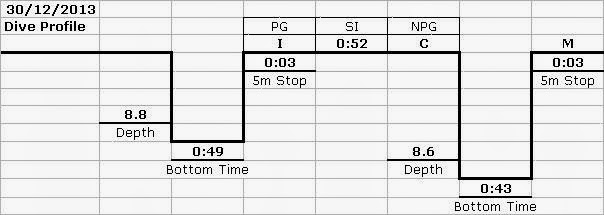It’s quite simple in theory. According to Archimedes:
“Any object, wholly or partially immersed in a fluid, is
buoyed up
by a force equal to the weight of the fluid displaced by the object.”
But before we can say "Eureka" and go diving it
gets a bit more complex. Neutral buoyancy is not just about Archimedes’
principle alone because his physics only applies once the “body” either sinks fully to
the bottom or is on the surface; which is exactly not where a diver wants to
be.
So in fact for the object (the diver) to be neutrally buoyant,
it has to be expressed as:
Mass x the force of gravity = mass density of the fluid x volume displaced
by the body actually in contact with the fluid x the force of gravity = 0
Now if that’s not an eyeful then imaging what it must be like to
try to control it in 9 metres of sea-water, little to no visibility and in the face of a current .
Down we went none-the-less. The focus on this dive was to concentrate on
the one skill that we needed to control but would take a lifetime to master –
neutral buoyancy. It was here that we saw yet again the value not just an
instructor but that of a true master. The difference is that instructors teach the
science of diving; masters take it to a whole new level where it is no longer a
science but an art form. Even though I had seen it before, I watched the
demonstration mesmerised and somewhat envious of how easy it all seemed.
Then it was my turn. With the memory of what I had just witnessed fresh in my head, I knelt on the sea-bed. Because of the weights I was
carrying, I was negatively buoyant. I filled my lungs to capacity – nothing
happened. I pumped a tiny bit of air into my BCD – nothing; a bit more –
nothing. A tiny bit more and there it was: my knee lifted off the sea-bed. I filled my lungs to capacity. Too much, I was rising
too fast. I exhaled and sank back down. A tiny bit more air in the BCD and shallower
breathing did the trick. I got it to a point where I could control my rising
and falling just by the amount that I was filling and emptying my lungs with. Mastering how much air you
breathed in and out for the given conditions in order to remain suspended in the
water; neither rising and falling is what the complex formula is all about.
The next step was to do the same thing but in the horizontal
position. Enter, stage left, the fin pivot. Again a master stroke: my
instructor noticed that with so much weight tied to my waist, it was almost
impossible to remain horizontal as the weight was distributed unevenly. He
instructed me to move the weights higher up to just below my rib-cage. Problem
solved.
For a stroke of pure genius:
our instructor wanted to reinforce the fact that we did not need to
keep fiddling with pumping air into or letting air out of the BCD to manage neutral
buoyancy. You could achieve the same
thing by breathing alone. After all, he told us on the surface, the lungs had a
capacity of seven litres of air whereas the BCD, for the purposes of neutral
buoyancy has just one.
To demonstrate the point, he exhaled, removed a weight that
he had stored in his BCD and placed it on the sea-bed. Normally that would
automatically result in positive buoyancy as soon as he breathed in. Quite the
contrary; purely by controlling his breathing he remained perfectly neutrally
buoyant. He then got us to do the same.
Initially, the moment I removed a weight, I started to rise. Soon
however, I got the point. With shallower breathing I was able to not only
maintain neutral buoyancy but also to rise and fall at will purely by
controlling the amount of air that was going in and out of my lungs. The
“secret” was that you should never have to fill your lungs to capacity just to
get positively buoyant. Nor should you have to totally empty your lungs to go
the other way. It is in shallower breathing that you ride the fine line that we
know is neutrality.
What a moment that was and what was more, it was
a very liberating experience. The dive became more enjoyable and closer to what
the sport is all about when you did not have to concern yourself with the technology.
Once we were back on the surface, we practiced removal and
replacement of the BCD and everything attached to it and then it was back on
the boat for the last time in the course.
Here’s the Dive
profile for the day:












